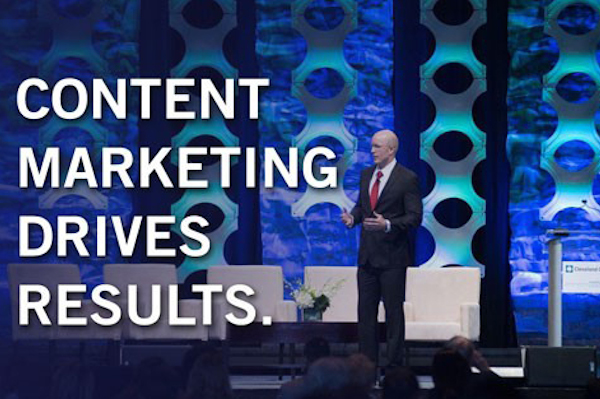
Stamats Insights
January 21, 2019

When digital marketing giant MailChimp announced it was partnering with USPS to provide a direct mail postcard service, it came as a big surprise to many organizations in the content marketing industry. Whatever happened to “digital first”?
But savvy digital marketers know that it’s never been print vs. digital. Shareable blogs and social media are the new word of mouth. Before digital, it was never print vs. word of mouth – it’s always been a combination of platforms, and will be for the foreseeable future.
In fact, we ascribe to a method that deliberately integrates traditional and digital distribution – with the same hub content pieces. This method is not proprietary – it’s a content marketing best practice known as COPE: create once, publish everywhere.
However, it can feel overwhelming for lean marketing and web teams to crank out content that is timely, relevant and useful on a continual basis. There are plenty of reasons to implement content marketing in any organization, but there are ample excuses as to why organizations don’t do it. Below, we address four of of the most common concerns clients have shared before they took the lucrative leap into content marketing.
Do you sell a product or service? Do you have an opinion? Then, yes, you do have something interesting to share with your audience. Content marketing is an active conversation with your audience. Give the people what they’re asking for. Provide the information they want and need to drive business results.
Every piece of content you distribute must be useful, relevant and interesting.
Your content also must be tied to business goals. And it must be created, produced and distributed in a way that is searchable and easy to find. If you want to be found for something, position the content as only your organization can around those topics, problems and questions, and relentlessly share it across digital and print.
Organizations say “we don’t have time” because their staff spends too many hours working on projects that don’t generate results. For content marketing, that means creating articles, emails, social media posts and mailers that no one engages with or reads. Some of this is an educated guess. You can’t say 100 percent whether a certain story or image will take off, but if you know your audience’s goals, wants and needs, you will learn what is newsworthy and relevant to them. Then produce more of that!
On the flip side, some people say organizations don’t need more content, but rather more deliberate content. We have not found this to be true. Organizations that achieve content marketing success strike a balance between creating evergreen “cornerstone content” and new, trending content, as well as effectively repurposing and distribution strategies.
For example, With one hub piece of content, you can expand and optimize the reach of your message to more and new people in a relevant way without investing excess time in recreating the wheel. You could produce a cornerstone content webinar and use the recorded content to produce a podcast with a transcription. Next, you potentially could use that content to create a white paper, multiple blog articles and a series of social media posts that are tweaked for the specific platforms and audiences.
And it’s always worked just well enough that stakeholders haven’t fussed. But imagine complementing your print efforts with an integrated digital strategy to increase the reach and shareability of your content. Content marketing can take your current successes from meeting the goal to blowing it out of the water.
When it comes to content production, we often hear organizations subscribing to standards from years past. For example, optimal web content used to be 300 – 500 words. However, this content might be flagged today by Google as too thin or non-expert content. Today’s best practice for how long an article should be is closer to 750 – 1,200 words. Next year, it will probably be different, and that’s the nature of marketing, especially on digital.
The same principle goes for social media, which used to be entirely organic. Today, it’s almost entirely pay-to-play and driven by constantly changing algorithms. Without paid promotion, expect minimal views of your content.
Not true. When done right, content marketing can drive 30 percent or more of your web traffic, resulting in high-quality lead generation and trackable conversions. You can achieve this by writing content that is optimized for search and that is tailored to active searches in your target audience. Write this way regardless of whether you intend to publish in print, online or both. The phrasing and keywords used in web optimized content pop out at readers on both print and digital.
However, content marketing is a marathon, not a sprint. Most organizations need to create and distribute quality content for six months to a year to show return on investment (ROI). But the potential thereafter is limitless with continual publishing and strategic distribution of cross-channel content that is relevant to your audience.
We make content marketing sound easy because our job is to make it easy for clients But a lot of work goes into content creation. Successful organizations start with data. They investigate what people are searching, clicking and consuming in order to determine trends in user engagement and what to create next.
Because of this and the ever-changing best practices across channels, writing has never been harder. Now we measure frequently, and we have goals for every piece of content in digital and print:
Content marketing works. As many as 80 percent of attendees to the annual Content Marketing World conference are new year over year. The Content Marketing Institute taps into the needs of these new attendees year round by creating content that answers questions this section of the market is asking online. What is content marketing? How can I get started?
As you consider the nuanced needs of your audience, keep these content marketing trends top of mind heading into your next planning or production cycle:
Whether your goal is to reach more people, improve sales or generate more leads, a content marketing strategy that integrates print and digital media can help you drive business results.
Ready to Get Started?
Reach out to us to talk about your strategy and goals.